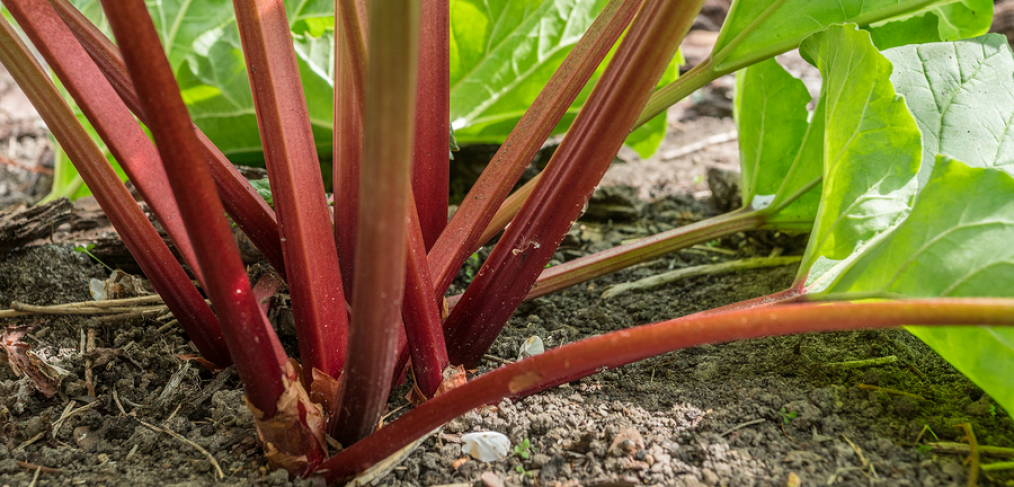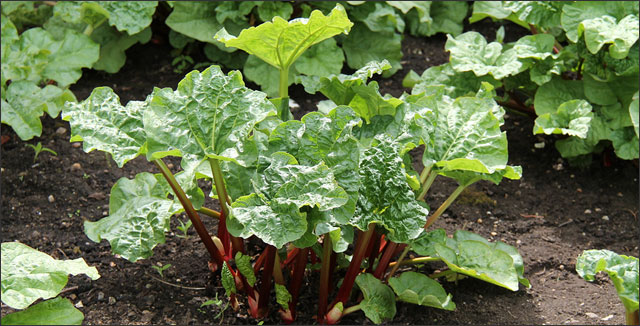
Surprising Uses of Rhubarb – Gardening Tips

There is nothing better in the summer than that first strawberry rhubarb pie or crisp. The two plants are ripe at the same time and if you can get the strawberries fresh from the garden and super sweet, there’s nothing better than that tart, sweet pairing.
It reminds me of summers gone by and holds the promise of future sweetness and happy times. When I was growing up, we moved to one of our houses and inherited a rhubarb patch. I remember how huge it was in late summer, by the time we got into the house. The stalks were green instead of red.
The next year my mom harvested the rhubarb with her strawberries and made a pie. She talked about rhubarb as something you either inherit or have to bum off a neighbor. It wasn’t found in grocery stores.
To this day, I know I’ll find rhubarb in only one or two grocery stores for a short time in the beginning of the summer. It’s one of those plants gaining in popularity but not yet popular enough to be mass produced.
Where Can You Find Rhubarb?
In fact, growers are working on a technique called micropropagation that will aid growers in mass production of healthy plants. Growers have faced some of the same questions my mom did back then – how can I get some rhubarb if I don’t have my own patch already? Where do I find the healthiest stock?
It’s a plant that seems to just be passed around from garden to garden. That’s what I like about it. But micropropagation – taking one of the minute growing tips called a meristem from the plant and starting a test tube culture – may ensure we’d all have access to disease free plants and growers would be able to grow rhubarb year round more rapidly.
Another fun fact you might not know: a plant called burdock is often confused for rhubarb. It’s a weed, part of the daisy family, and can be seen in the wild. It looks a lot like rhubarb with large green leaves and reddish stalks that grow close to the ground.
The interesting thing is that it can be cultivated in a garden and is edible including the roots, stems, and leaves. This is unlike rhubarb, whose leaves and flowers are poisonous. So, if you find some burdock along a path, it might not make it into your tart.
However, you can certainly grow it in your garden and use it for a variety of purposes. Some say it tastes similar to a lotus plant, with a sweet crunch. Burdock tea has a mild flavor and some amazing properties.

The Surprising History of Rhubarb
Rhubarb, on the other hand, is not native to the United States. It was brought here most likely by European settlers to New England.
Today, Michigan and Ontario are two of the most prolific growers of rhubarb in North America. They are two of the only places you can find winter rhubarb.
Rhubarb is actually very old. It was well known to Marco Polo, as it had been cultivated in ancient China for millennia. That’s right! There are records dating back to 2700 BC in China showing that rhubarb was cultivated for medicinal purposes.
It turns out that for a long time no one knew how good it tasted in a pie. They just wanted it for its purgative properties. That is for colon health. The theory is that the technical name of its genus, Rheum, is said to be derived from the word Rha, which is the ancient name of the Volga River where the plant was found.
Others think it may be from the ancient Greek word rheo, which means “to flow” in a nod to its medicinal properties. There was a famous ancient Greek pharmacologist who spoke of the root known as rha.
There are also many records of rhubarb being given to this or that emperor for fever or taken in times of plague. Eventually, it was exported to Europe along with tea, where it was discovered, no doubt by moms and grandmas everywhere that its stalks tasted really great in a pie.
However, lest you decide to try rhubarb root for its “purgative properties,” it’s generally known that the only variety to really offer these properties is the kind found in the mountainous regions of the Kansu province. Or you could visit an herbalist. That would probably be easier.
Propagation of Rhubarb
If all you are really after is pie, there are several ways to borrow some from a friend or neighbor. You can divide the root mass, grow it from seeds or – if you’re a serious grower – use a tissue culture. You can often purchase a rhubarb plant or rhizome ready to plant.
If you are attempting to give a plant to a friend, make sure your plant is 4-5 years old before you dig it up to divide the crown. You can divide in the spring or fall, but spring is easier, as the plant will be smaller at that time.
Wait until early growth has just started in order to see best where to divide, and then dig up the crown. Be careful not to damage it. You can cut the roots into several pieces.
At this point, you can split dormant crowns between the large buds or “eyes” in order to leave at least a 2-inch cross section of storage root with each bud. You have to be extra careful not to break off the buds, which are delicate and easily broken. The roots themselves are very tough and not easily damaged. However, if you plan to store and not plant right away, they need to be protected from drying or freezing.
If you have a very small bud, you will get a small plant for the first few years after planting. So you want to make sure you mark as you divide which plants are more vigorous to use as planting stock for the next spring.
How to Care for the Rhubarb Plant
If you, like my mom, have inherited a rhubarb patch and really don’t know what to do with it, have no fear! Rhubarb likes compost and they need to be watered well and checked frequently, just as you would do with any garden plant. You can also cut off the largest leaves on a growing plant as they use up much of the plant’s energy and are not edible.
Takeaway
Rhubarb is a surprisingly fascinating plant that isn’t native to this continent. It has been adding tartness to pies and crumbles for centuries in Europe and America. Before that, it was as famous as tea for its medicinal properties. It was also a staple of trade along the Silk Road. What’s your favorite rhubarb recipe?



